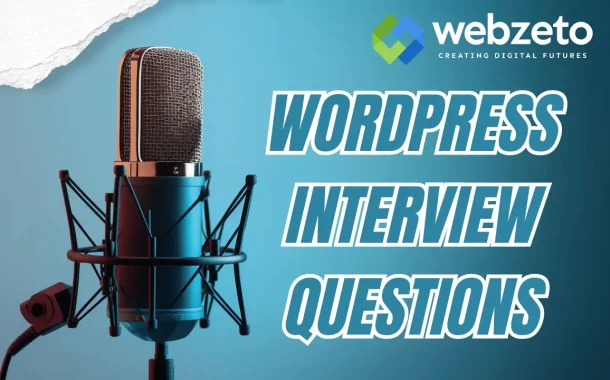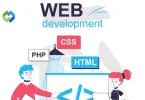In web development, WordPress plays a crucial role by democratizing the process of building websites. Its accessibility lowers the barrier of entry for individuals and businesses seeking an online presence. Moreover, its vast ecosystem of themes and plugins allows for endless customization, catering to diverse needs and preferences.
Table of Contents
1. Basic WordPress Concepts
WordPress is a free and open-source content management system (CMS) that allows users to create, manage, and publish digital content without needing advanced technical skills. It provides a user-friendly interface where users can easily add, edit, and organize their content, including text, images, videos, and more.
Originally developed as a blogging platform, WordPress has grown into a versatile tool used to build various types of websites, from personal blogs and portfolios to business websites and e-commerce stores.
WordPress.com vs. WordPress.org
WordPress.com is a hosting service provided by Automatic. Users can create and host a WordPress website without worrying about server management or technical details. It offers various plans with different features and levels of customization. On the other hand, WordPress.org is the official website of the open-source WordPress software.
Users can download the WordPress software for free and install it on their web servers. This option provides more flexibility and control over the website’s setup and customization but requires users to manage their hosting and domain.
Structure of WordPress
WordPress is structured into three main components.
- Themes: Themes control the visual design and layout of a WordPress website. Users can choose from thousands of free and premium themes or create their own to customize the website’s appearance.
- Plugins: Plugins are add-on software that extends WordPress functionality. They allow users to add features such as contact forms, e-commerce capabilities, SEO optimization, and more without needing to write custom code.
- Core: The WordPress core is the foundation of the software, containing the essential code and features needed to run a WordPress website. A community of developers regularly updates it to ensure security, performance, and compatibility with new technologies.
2. WordPress Installation and Setup
By following these steps and understanding the WordPress dashboard. You can successfully install and set up a WordPress website to suit your needs.
Steps to Install WordPress
- Choose a Web Hosting Provider: Select a web hosting provider that meets your needs and budget.
- Domain Registration: Register a domain name for your website or use a subdomain provided by your hosting provider.
- Download WordPress: Download the latest version of WordPress from the official website or use a one-click installer provided by your hosting provider.
- Upload WordPress Files: If you’re using a one-click installer, follow the instructions provided. Otherwise, upload the WordPress files to your web server using an FTP client.
- Create a Database: Create a MySQL database and user for your WordPress installation using your hosting provider’s control panel.
- Run the WordPress Installation Script: Navigate to your website’s URL in a web browser and follow the on-screen instructions to complete the installation process.
Configuring WordPress Settings
- Site Title and Tagline: Set the title and tagline for your website.
- Permalinks: Choose the URL structure for your website’s pages and posts.
- Reading Settings: Configure the settings for your website’s homepage and blog posts.
- Discussion Settings: Set options for managing comments and notifications.
- Media Settings: Specify the default sizes for uploaded images.
- Privacy Settings: Choose whether to allow search engines to index your site.
Understanding the WordPress Dashboard
- Dashboard Overview: The WordPress dashboard is the control center for managing your website. It provides an overview of your site’s activity, including recent posts, comments, and updates.
- Posts: Create and manage blog posts and articles.
- Pages: Add and edit static pages such as About Us and Contact.
- Media: Upload and manage images, videos, and other media files.
- Appearance: Customize your website’s appearance by selecting themes and customizing the site’s design and layout.
- Plugins: Extend WordPress functionality by installing and activating plugins.
- Users: Manage user roles and permissions for accessing and managing your website.
- Settings: Configure general, writing, reading, discussion, media, and permalinks settings for your website.
3. WordPress Themes
WordPress themes play a pivotal role in shaping the visual aesthetics and layout of a WordPress website. They consist of a collection of files, including PHP, CSS, and JavaScript, which collectively define the appearance and functionality of a site. Each theme offers a unique design, style, and set of features, catering to diverse preferences and requirements.
Installation and Activation
To install a WordPress theme, users can access the “Themes” section within the WordPress dashboard. From there, they can explore and choose from a vast array of free and premium themes available in the WordPress theme directory or from third-party sources. Once a theme is selected, users can install it with a simple click and activate it to make it the active theme for their website.
Customization Options
Upon activation, users can further customize the theme to align with their brand identity and desired design aesthetics. Most WordPress themes offer customization options through the WordPress Customizer tool, allowing users to adjust settings such as colors, fonts, header styles, and layout preferences. Additionally, users can leverage the power of child themes and custom CSS to implement more advanced and tailored modifications to their chosen theme.
Popular WordPress Themes
Popular WordPress themes like Divi, Astra, OceanWP, and GeneratePress have gained widespread popularity due to their versatility, customization options, and seamless integration with page builders and plugins. These themes empower users to create visually stunning and feature-rich websites without the need for extensive coding knowledge, making them ideal choices for both beginners and experienced developers alike.
4. WordPress Plugins
WordPress plugins are essential tools that extend the functionality of a WordPress website beyond its core features. They offer a convenient way to add new features and capabilities without the need for coding expertise. With thousands of plugins available, users can customize their websites to suit their specific needs and goals.
Installation and Activation Process
To install a WordPress plugin, users can navigate to the “Plugins” section within the WordPress dashboard and click on “Add New.” From there, they can browse the extensive plugin directory or upload a plugin ZIP file from a third-party source. Once installed, activating a plugin is straightforward, typically requiring just a click of a button.
Wide Range of Functionality
WordPress plugins offer a diverse range of functionality, catering to various aspects of website management and optimization. From SEO optimization and social media integration to performance enhancement and security measures, there’s a plugin available for almost every need imaginable. This versatility allows users to tailor their websites to meet their specific requirements.
Customization and Configuration Options
After installing a plugin, users can often customize its settings to suit their specific requirements. Many plugins come with intuitive interfaces and configuration options that allow users to fine-tune their functionality according to their preferences. This flexibility ensures that users can get the most out of each plugin while maintaining control over their website’s appearance and performance.
Popular WordPress Plugins
Some of the most popular WordPress plugins include Yoast SEO for search engine optimization, WooCommerce for e-commerce functionality, Contact Form 7 for creating customizable contact forms, and Jetpack for website security, performance optimization, and site management. These plugins have garnered widespread acclaim for their reliability, effectiveness, and user-friendly interfaces, making them indispensable tools for WordPress users worldwide.
5. WordPress Security
WordPress security is paramount for protecting your website from potential threats such as hacking attempts, malware infections, and data breaches. Understanding the common vulnerabilities and implementing robust security measures are crucial steps in safeguarding your WordPress site. By staying informed about security risks and best practices, website owners can effectively mitigate the risk of security incidents and ensure the integrity of their online presence.
Key Security Measures
Implementing strong passwords, keeping WordPress core, themes, and plugins updated, and regularly backing up your website are fundamental security measures. Additionally, limiting login attempts, using HTTPS encryption, and installing security plugins can further enhance your website’s security posture. These proactive steps form the foundation of a comprehensive security strategy and help to fortify your WordPress site against potential threats.
Common Security Vulnerabilities
Common security vulnerabilities in WordPress include outdated software, weak passwords, insecure hosting environments, and unsecured plugins and themes. Hackers often exploit these vulnerabilities to gain unauthorized access to websites or inject malicious code. By identifying and addressing these vulnerabilities promptly, website owners can reduce the risk of security breaches and protect their sensitive data from exploitation.
Best Practices for WordPress Security
Adopting best practices such as using secure hosting, regularly updating software, performing security audits, and implementing a web application firewall (WAF) can significantly reduce the risk of security breaches. Additionally, educating yourself and your team about security protocols and staying informed about the latest security threats are essential for maintaining a secure WordPress website.
By prioritizing security awareness and proactive measures, website owners can create a robust defense against potential security threats and ensure the long-term integrity of their WordPress sites.
Security Plugins and Tools
Numerous security plugins and tools are available for WordPress users to enhance their website’s security. Popular options include Wordfence Security, Sucuri Security, and iThemes Security, which offer features such as malware scanning, firewall protection, and login security enhancements.
These tools provide additional layers of protection and monitoring, allowing website owners to detect and mitigate security threats effectively. By leveraging the capabilities of security plugins and tools, WordPress users can strengthen their website’s defenses and maintain a secure online presence.
6. WordPress Performance Optimization
WordPress performance optimization involves improving the speed, responsiveness, and overall efficiency of a WordPress website. A fast-loading website not only provides a better user experience but also contributes to improved search engine rankings and higher conversion rates.
Key Performance Optimization Techniques
Optimizing WordPress performance involves various techniques, including caching, image optimization, minimizing HTTP requests, and leveraging content delivery networks (CDNs). Additionally, optimizing database queries, enabling GZIP compression, and implementing lazy loading for images and videos can further enhance website speed and performance.
Importance of Website Speed
Website speed is crucial for user satisfaction and engagement. Research indicates that visitors are more likely to abandon slow-loading websites, resulting in lost traffic and revenue. Moreover, search engines like Google consider website speed as a ranking factor, making performance optimization essential for improving search engine visibility and organic traffic.
Performance Monitoring and Testing
Regular performance monitoring and testing are essential for identifying areas of improvement and ensuring continued optimization efforts. Utilizing tools like Google PageSpeed Insights, GTmetrix, and Pingdom allows website owners to analyze performance metrics, identify bottlenecks, and implement necessary optimizations.
Best Practices for Performance Optimization
Implementing best practices such as choosing a lightweight theme, minimizing external scripts and plugins, and optimizing server resources can significantly improve WordPress performance. Additionally, optimizing images, using a content delivery network (CDN), and implementing browser caching are effective strategies for enhancing website speed and responsiveness.
7. WordPress SEO
WordPress SEO involves optimizing a WordPress website to improve its visibility and rankings in search engine results pages (SERPs). By understanding how search engines crawl, index, and rank content, website owners can implement targeted strategies to enhance their site’s SEO performance and attract more organic traffic.
Key SEO Optimization Techniques
WordPress offers numerous built-in features and plugins that facilitate SEO optimization, including customizable permalinks, meta tags, XML sitemaps, and schema markup. Additionally, optimizing content for relevant keywords, improving website speed and mobile responsiveness, and building high-quality backlinks are essential SEO techniques for WordPress websites.
Importance of Search Engine Visibility
Search engine visibility is crucial for driving organic traffic and attracting potential customers to a WordPress website. Websites that rank higher in search results are more likely to receive clicks and visits, leading to increased brand exposure, website traffic, and conversion opportunities. Recognizing the importance of search engine visibility motivates website owners to prioritize SEO optimization as a fundamental aspect of their digital marketing strategy.
SEO Monitoring and Analytics
Regular monitoring of SEO performance and analytics is essential for evaluating the effectiveness of optimization efforts and identifying areas for improvement. Utilizing tools like Google Analytics, Google Search Console, and SEO plugins allows website owners to track key metrics such as organic traffic, keyword rankings, and user engagement, providing valuable insights into the effectiveness of their SEO strategies.
Best Practices for WordPress SEO
Adhering to best practices such as creating high-quality, relevant content, optimizing on-page elements, and improving website speed and user experience helps improve WordPress SEO performance. By following these guidelines and implementing SEO strategies that align with their specific goals and target audience, website owners can increase their website’s visibility and rankings in search engine results.
8. WordPress Maintenance and Updates
WordPress maintenance involves regular upkeep and management tasks to ensure the continued health, performance, and security of a WordPress website. It includes activities such as updating WordPress core, themes, and plugins, performing backups, monitoring website security, and optimizing performance.
Importance of Regular Maintenance
Regular maintenance is crucial for keeping a WordPress website running smoothly and securely. By staying proactive with updates and security measures, website owners can prevent potential issues, such as security breaches, data loss, and performance degradation, that may arise from outdated software or vulnerabilities.
Updating WordPress Core, Themes, and Plugins
Regularly updating WordPress core, themes, and plugins is essential for maintaining website security and functionality. Updates often include bug fixes, performance enhancements, and security patches that address known vulnerabilities. By keeping software up to date, website owners can reduce the risk of security breaches and ensure compatibility with the latest web technologies.
Backup and Restore Procedures
Performing regular backups of a WordPress website is critical for safeguarding against data loss and website downtime. Backup solutions, such as plugins or web hosting providers, enable website owners to create automated backups of their website files and databases. In the event of a security incident or server failure, having a recent backup allows for quick restoration of the website to its previous state.
Security Measures and Monitoring
Implementing robust security measures, such as using strong passwords, limiting login attempts, and installing security plugins, helps protect a WordPress website from potential threats. Additionally, regularly monitoring website security through tools like security plugins and website scanners allows website owners to detect and respond to security issues proactively.
Optimizing Performance
Optimizing website performance through techniques such as caching, image optimization, and code optimization helps ensure a fast and responsive user experience. Regular performance monitoring and testing allow website owners to identify areas for improvement and implement optimizations to enhance website speed and efficiency.
9. WordPress Customization and Development
WordPress customization and development involve tailoring WordPress websites to meet specific requirements and preferences. It includes customizing themes, developing custom plugins, and utilizing WordPress APIs and hooks to extend functionality and achieve desired outcomes.
Customizing WordPress Themes
Customizing WordPress themes allows website owners to personalize the appearance and functionality of their websites to align with their brand identity and design preferences. This may involve modifying colors, fonts, layouts, and other design elements using the WordPress Customizer or by editing theme files directly.
Developing Custom Plugins
Developing custom plugins enables website owners to add unique features and functionality to their WordPress websites that are not available out of the box. This may include creating custom post types, adding custom fields, integrating third-party APIs, or implementing complex business logic tailored to specific needs.
WordPress APIs and Hooks for Developers
WordPress provides a rich set of APIs and hooks that developers can leverage to extend and customize WordPress functionality. This includes the REST API for integrating with external systems, the Plugin API for developing custom plugins, and various action and filter hooks for modifying core functionality and adding custom code snippets.
Importance of Customization and Development
Customization and development are essential for creating websites that stand out in a crowded online landscape and meet the unique needs of businesses and individuals. By tailoring WordPress websites to specific requirements, website owners can enhance user experience, improve efficiency, and achieve their goals more effectively.
Best Practices for Customization and Development
Adhering to best practices such as using child themes for customization, following coding standards and best practices, and testing thoroughly across different environments helps ensure the success of WordPress customization and development projects. Additionally, staying informed about the latest WordPress trends and technologies empowers developers to deliver innovative and effective solutions.
10. WordPress Hosting
WordPress hosting refers to the service provided by web hosting companies specifically optimized for hosting WordPress websites. It includes features such as one-click WordPress installation, specialized WordPress support, and server configurations optimized for WordPress performance and security.
Types of WordPress Hosting
There are several types of WordPress hosting available, including shared hosting, managed WordPress hosting, virtual private servers (VPS), and dedicated servers. Each type offers different levels of performance, scalability, and control, catering to the needs and budgets of different website owners.
Factors to Consider When Choosing a Hosting Provider
When selecting a WordPress hosting provider, it’s essential to consider factors such as reliability, performance, security, support, and scalability. Additionally, evaluating features such as server uptime, speed, backup options, security measures, and customer support can help determine the best hosting provider for your needs.
Recommended WordPress Hosting Providers
Several web hosting companies specialize in WordPress hosting and are known for their reliability, performance, and support. Some popular options include Bluehost, WordPress on Godaddy, SiteGround, WP Engine, Kinsta, and Flywheel, each offering a range of hosting plans tailored to different budgets and requirements.
Migrating to a New Hosting Provider
If you’re considering switching hosting providers, it’s essential to plan the migration carefully to minimize downtime and ensure a smooth transition. Many hosting providers offer migration services or plugins to simplify the process, and it’s advisable to perform thorough testing after migration to ensure everything is functioning correctly.
FAQs
Q. What is Shared Hosting?
Shared hosting is a type of hosting where multiple websites share the same server resources, such as CPU, memory, and disk space.
Q. What is Managed WordPress Hosting?
Managed WordPress hosting is a specialized hosting service optimized for WordPress websites. It typically includes features like automatic updates, security monitoring, and expert WordPress support.
Q. How Does VPS Hosting Differ from Shared Hosting?
VPS (Virtual Private Server) hosting provides dedicated resources to each website, offering more control, flexibility, and scalability than shared hosting, which shares resources among multiple sites.
Q. What Are the Benefits of Dedicated Servers?
Dedicated server hosting offers exclusive use of an entire server, providing maximum performance, security, and control. It’s ideal for high-traffic websites or applications that require dedicated resources.
Q. How Can I Choose the Right Hosting Plan for My WordPress Site?
When choosing a hosting plan, consider factors like your website’s traffic, performance requirements, budget, and technical expertise. Research different hosting providers, compare plans, and look for features that align with your needs.
Conclusion
Preparing for a WordPress interview requires a solid understanding of key concepts, best practices, and technical skills relevant to WordPress development, customization, and management. By familiarizing yourself with common interview questions and topics such as WordPress basics, theme and plugin development, performance optimization, security measures, and hosting considerations, you can confidently showcase your expertise and suitability for WordPress-related roles.
Staying updated with the latest trends, tools, and technologies in the WordPress ecosystem demonstrates your commitment to continuous learning and growth in this dynamic field. With thorough preparation and a passion for WordPress, you’ll be well-equipped to ace your interview and embark on a rewarding journey in the world of WordPress development and management.














